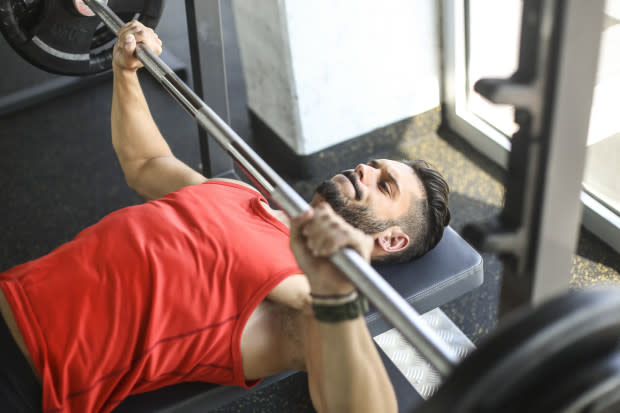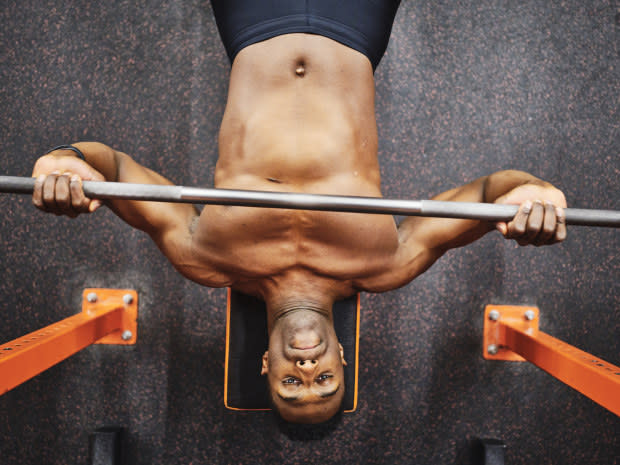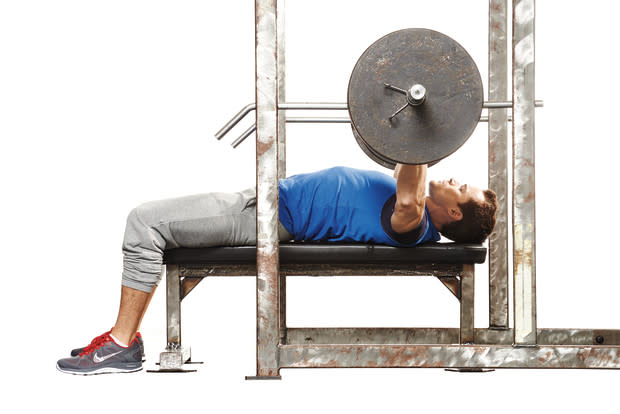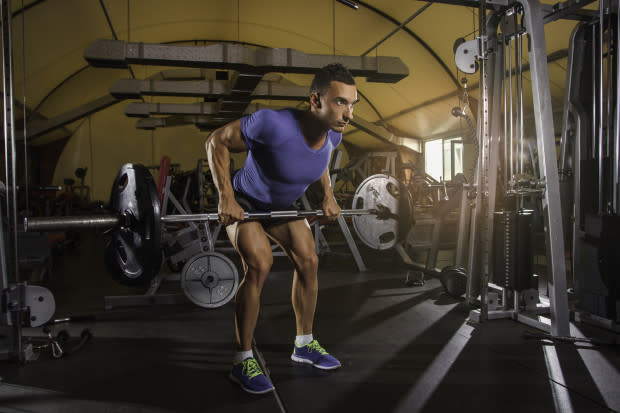How to Increase Your Bench Press
You’re not alone. You want to increase your bench press. So does nearly every athlete who’s ever moved a barbell. It's among the best chest exercises at the gym, yet many struggle to add weight to their bench press simply because they don’t know how to do it right. But even people with good form can struggle to break through plateaus and bench more weight. These research-backed and gym-tested tips will help fix these issues. Here's how to increase a bench press.
Muscles Worked in the Bench Press
The classic flat barbell bench press is a horizontal pushing exercise, targeting three muscle groups that work in harmony. First, the chest muscles (pectoralis) are enlisted, assisted by the triceps—especially their lateral head, and the front (anterior) deltoids.
Depending on the version of bench press you do and the technique used, you can manipulate this to skew the amount of involvement each muscle group listed above receives. We’ll also start with the disclaimer that the barbell flat bench press, though an impressive feat of strength, is not the optimal choice for building muscle in any one of the above muscle groups (compare this to other more targeted movements like cable flyes, dumbbell bench presses, and dips, which are much more stimulating for the pec fibers exclusively). It’s nothing major, but it’s worth keeping in mind if building a bigger chest or arms is one of your goals.
How Much Can the Average Man Bench Press?
The most pressing strength question so many men have is: “How much am I supposed to be able to bench press?” There's no magic number as there are many factors at play: injury history, training experience, calendar age, body weight, and limb length.
However, a good goal for most athletes is being able to match your bodyweight for a set of 6 to 8 reps if you're within an average range for bodyweight. Always remember that you're more likely to possess more relative strength if you're a smaller lifter, and are more likely to possess more absolute strength if you're a bigger lifter.
That means someone who weighs 140 pounds will be more likely to press 1.5 or 2 times his bodyweight before a lifter who's 300 pounds will achieve the same feat. The 300-pound dude may have a heavier 1 rep max, but to scale, the numbers won't quite match.

Proper Form: How to Bench Press
Before we cover how to increase your bench press, let's start with basic bench press tips. Success begins with a proper setup. Like many movements, being stable and tight is the key. To achieve that, first establish these four points of contact before unracking the bar.
Set Your Points of Contact
Feet. Position your feet firmly on the ground, and keep your knees bent at a 90-degree (or less) angle. The ball of each foot should be applying the most force into the floor, and it’s OK if your heels come off the ground slightly.
Butt. This goes without saying. The butt is the key midpoint between head and feet for optimal stability. Never raise your butt off the bench press bench. Not before or during the lift.
Upper back and shoulders. The contact point on the bench via the upper back and shoulders is the main hub for your force production. The bench press can be a big ask for the shoulder joint itself, and the opportunity to create a sturdy base under the bar helps stabilize the joint. Your lower and mid back should arch up, that’s another element of a proper, safe bench press. This will allow you to raise your ribcage, and pull the shoulder blades back toward each other—one of the most essential coaching cues that will protect your shoulder joints from injury.
Head. It’s a very common practice to raise your head off the bench during a set. Do your best to do the opposite, and drive it into the bench instead on each rep, in order to maintain spine neutrality in the name of safety and neck health.
Position Under the Bar
Once you’re set up with the above bench press tips, position your eyes under the racked bar. Too far out and the bar will be too difficult to unrack; too far in the other direction, and you’ll run into the uprights with the bar during your reps.
Choose a hand position that promotes a vertical arm position under the bar (look for a 90-degree elbow angle as you reach the bottom of the press), and hold the bar tight with thumbs wrapped around.
Press the Bar
Keeping the shoulders pulled back, lower the bar under control to the nipple line.
Make brief, gentle contact on the torso, and exhale as you press the weight back up to the top. That's 1 rep.
Press your feet into the ground on each press to get more drive. And don’t cheat yourself—fully extend the elbows on each rep.

Common Bench Press Problems—and Their Solutions
Every lifter is going to hit speed bumps, even with our bench press tips, when figuring out how to increase a bench press. Fortunately, these prevalent barriers to benching larger numbers all have straightforward fixes.
1. Shoulder Pain
The bench press can be a stressful exercise for the shoulder joint. But finding the right technique and range of motion for your body can prevent shoulder pain. If you’re a lifter with long arms, it’s even more important that the shoulder blades remain retracted. Following the setup cues above can get a lifter far, but the tension applied to the bar matters too. Counteract the downward stress forces by either pulling apart on the bar or pushing inward on the bar (like bringing dumbbells together) with the hands as you press. This will disperse the pressure placed on the joint capsule and engage more chest or upper back muscle depending on the direction of the pull. Second, it may be helpful to stop a couple of inches above your chest to avoid vulnerable bottom end ranges.
2. Unstable or Shaky Bar Path
This problem is usually a telltale sign that a lifter is leaking strength somewhere in their technique. The most common culprit is the shoulder blades and lats. Try to pull the shoulders away from the ears while performing the lift (shrug downward) to depress the scapulae. This will help stabilize the shoulder and lend to a more bolstered pattern.
Second, look at the wrists. It’s common for many bench pressers to press with a broken-wrist position rather than a strong fist, stacked directly over the forearm. If the bar is resting in the palm of the hand and not closer to the base of it, the broken wrist position will result in the bar being positioned over empty space and unsupported. This can contribute to a wavering bar path when the lift is in action.
3. Poor Strength Off the Chest
Many lifters have better lockout strength than strength through the bottom. Ruling out shoulder discomfort or prior injuries, this can often be because of the way they’re used to performing the exercise—especially if they’re bouncing the bar off their chest. Remember, the bench press involves an eccentric and concentric component to the lift. Bouncing the bar off the chest requires less power from your muscles to perform that portion of the movement. Instead, focus on controlling reps and slowing the lowering phase down to avoid a bounce. This will do more to strengthen the entire range of motion and keep the lift honest. It may mean lowering the weight, but it will be worth it in the long run.
Exercises That Support the Bench Press
Eventually, performing the classic sets of 3, 5, or 8 isn’t enough to get past a bench press plateau. When you find yourself struggling with how to improve a bench press, these advanced lifting methods can come in handy. These strategies make lighter weight feel heavier, or let you focus on one aspect of the lift, and will lead to a jump in performance when you return to traditional reps. Try cycling them into your training for a full month.

James Michelfelder & Therese Sommerseth
1. Pin Press
Why It Works
Pressing from pins in a squat cage set 4 to 6 inches off the chest does a couple of things. First, it shortens the range of motion toward the lockout, which allows many to overload this portion. Secondly, allowing the bar to crash down to the pins means a lifter can focus more on the concentric reps only, and disengage for the eccentrics. This can mean more volume with a bit less muscle damage and soreness. It also encourages a lifter to press from a dead stop, requiring more true strength. If you're learning how to improve the bench press, focus on sets of 3 to 5 reps and aim to load heavier, not lighter.
How to Do It
Set up a flat bench in a squat cage and place the safety pins on either side a couple inches higher than chest level (or slightly higher), to start.
Lay the bar across the pins and slide in underneath.
Get tight, press hard, and allow the weight to return to the bottom.

James Michelfelder & Therese Sommerseth
2. 1.5 Rep Bench Press
Why It Works
The 1.5 rep method makes the chest work harder on each rep—double the effort without additional triceps work—due to more time under load without assistance from other muscles. The execution is simple. Perform sets of 3 to 5 reps.
How to Do It
Get set up in a typical bench press setup, to start.
Unrack the weight and lower the load slowly all the way to chest level.
Press the weight up, but only halfway up, and freeze at that midpoint for a full second count.
Lower it to the chest again.
Finally, finish the rep by pressing it all the way up to the top. That's 1 rep.

James Michelfelder
3. Chain Press
Why It Works
Attaching chains or bands to plates and hanging them from the bar will drastically challenge the stability factor for a bench press, as it requires extreme control and precision. You won’t be able to lift nearly as much using this method—begin with 50 percent of what you’d normally bench—and it’s recommended to use thicker bands rather than skinnier ones, so the amount of give is limited (and so the plates don’t hit the ground at the bottom of each rep). Returning to a normal bench press will feel like a piece of cake. Sets of 5 to 10 reps is recommended.
4. Cluster Reps
Why It Works
If strength is your goal, try getting more out of your three-rep max weight by adding short breaks between each rep. Rack the bar after your first rep, then rest for 10 seconds. Do the same thing after your second rep, then attack your third rep. Using this method, there's a good chance you'll have just enough left in the tank to squeeze out another rep, or even two. This is a great way to expose muscles to more volume under heavy loads.

5. Floor Press
Why It Works
The floor press stops your range of motion at 90 degrees. Using dumbbells and a neutral grip, it's a smart choice to improve lockout strength and boost the strength and size of your triceps—key players for a strong bench, and a well-rounded upper arm.
How to Do It
Lie on the floor with a dumbbell in each hand and hold the weights over your chest, to start.
Press them over your chest, then lower your arms until your triceps touch the floor (not your elbows). That's 1 rep.
Continue pressing from this shortened range of motion.

6. Low Incline Dumbbell Bench Press
Why It Works
Pressing dumbbells on a bench with a slight incline is one of the best moves to develop stronger, bigger muscles. This will give your elbows and wrists more freedom, reducing shoulder stress, since you're not restricted by a bar as the rep progresses. Moreover, the low incline and dumbbells target each chest muscle individually as they stabilize the weights for a greater workload.
How to Do It
Set an adjustable bench to a 45-degree angle and lie back against it with a dumbbell in each hand, to start.
Press the dumbbells straight overhead. Lower back down to start. That's 1 rep.
Reasons You’re Not Benching More
Lots of guys know that the bench press is a great way to develop a Schwarzenegger-like chest. But what many guys don't know is that this venerable exercise isn't as simple as lying on a bench, unracking the bar, and pushing it from point A to B. If you really want to engage the muscle fibers of your pecs, you've gotta meticulously position your body, complete a full range of motion, and monitor your technique as you push that weight.
If you're wondering why you're so weak in the bench press, make sure you avoid these seven mistakes and you'll be on your way to developing a bigger, more defined chest through superior strength and skill.
1. Focusing Too Much on a 1-Rep Max
Too many guys are concerned with how much weight they can bench press for a single rep rather than for sets of 7-12, which is where muscle growth tends to be best stimulated. Unless you're a powerlifter, stop maxing out every time you bench. Instead, focus on exhausting the muscle.
2. Not Grounding Your Feet
For whatever reason, some lifters think that putting their feet up is more effective for building the chest than placing them flat on the floor. While lifting legs does have its uses, you're better off keeping a solid base when bench-pressing because it centers most of your “neural drive” on the fibers of your pectoral muscles.
3. Off-Kilter Position on the Bench
Properly positioning your torso throughout each set—every rep, beginning to end—is one of the most important factors in developing a big chest. A sloppy torso position will shunt some of the muscle load onto other parts of your body, cheating your pecs out of some gains and potentially even setting yourself up for injury.
Keep these five tips in mind when benching:
Keep your ribcage up high.
Maintain a slight arch in your lower back.
Squeeze your scapulae together.
Keep your shoulders shrugged down and into the bench.
Keep your elbows near your body, rather than flaring them outwards.
Can't seem to hold that form through the entire set? Decrease the weight until you can handle it with perfect positioning.
4. Using the Wrong Grip
For a standard, straightforward bench press, space your hands about shoulder-width, or just slightly wider, apart. Most barbells have knurling (the rough patches) that can help guide you as a reference point.
Some guys will perform a narrow-grip bench press, but that's a different exercise with a different form.
Related: 30 Strength Training Exercises for the Best Upper Body Workouts of All Time
5. Bouncing the Bar Off Your Chest
It is absolutely ridiculous—as in literally deserving of ridicule—that anyone thinks it's smart to bounce a bar off their ribcage.
Even if bouncing lets you put more weight on the bar, everyone can see that it's just a way to leverage momentum—not muscle strength—to complete the lift. Bouncing the bar will only rob you of the potential benefits of the bench press while greatly increasing the chances you'll get catastrophically hurt. Your ribcage is pretty tough, but in a battle of bone against moving barbell, barbell wins.
You should be able to just touch the bar to your chest and sustain that weight there before pushing it back up. Imagine the middle of the barbell is covered wet paint. By the time you're done your set, you should only see a hint of the paint on your shirt—not a slathering.
6. Lifting Off-Tempo
No, it's not salsa dancing. But if you want to get the most profound pec pump from a bench press set, you need to control the bar at all times, and over consistent durations, if you want to maximize your gains.
Try this tempo: Lower the weight over 3-4 seconds, hold the stretch position for 1 second, and then explosively press to the top. That will maximize your range of motion and ensure you develop major strength and size.
7. Lifting Over a Small Range of Motion
Performing half-reps on the bench press is almost as bad as bouncing the bar off your chest. It's easy to see why guys do this: They load up all kinds of plates on the bar, barely inch it along, and then brag to the whole gym about how much they can bench. Here's the thing: No one's buying it.
Instead, work out like you mean it. To recruit every fiber in your chest, lower the bar to full stretch on each rep—for most people, that means lightly touching the bar to your the chest or to your sternum—and then press the bar straight up to lockout, while consciously squeezing the pecs into a tight contraction.

8. You Forgot About Your Back
A strong, powerful back will provide much-needed upper body stabilization when you start piling on the weight. Make sure you're performing movements like the barbell deadlift and barbell bent over rows - those movements are big, complex strength-builders and will pack on a solid structure. Perform 3-6 sets, 6-8 reps, longer rest periods, 1-3 minutes. Complement these big lifts with a couple of accessory movements: lat pull downs and seated cable rows. Perform 3-6 sets, 12-15 reps, moderate rest periods, 30-60 seconds. Do not train these to failure.
9. Benching Too Often
We know what you're thinking: How to increase your bench press if we're telling you not to bench? There are many alternate or accessory exercises that'll help improve your bench press. Utilize a variety of external rotation and rotator cuff work to make sure your shoulders stay healthy and structurally balanced. Both military presses and pullups have shown to have carry over to a bigger bench, so make sure they're in your program. Dumbbell presses can also help establish better shoulder stability and a greater range of motion, and triceps work will help with a stronger lockout. Finally, the bench press is a pretty demanding exercise on one of the most complicated and injury-prone joints in your body, your shoulders. Don’t be afraid to take some time off bench pressing for a phase to concentrate on supplemental and injury-preventing movements.
You can also increase your bench press with our six-week training program to add 15 pounds to your bench press.
Solve the daily Crossword

